LabGuy's World: A 75 ohm buffered video amplifier
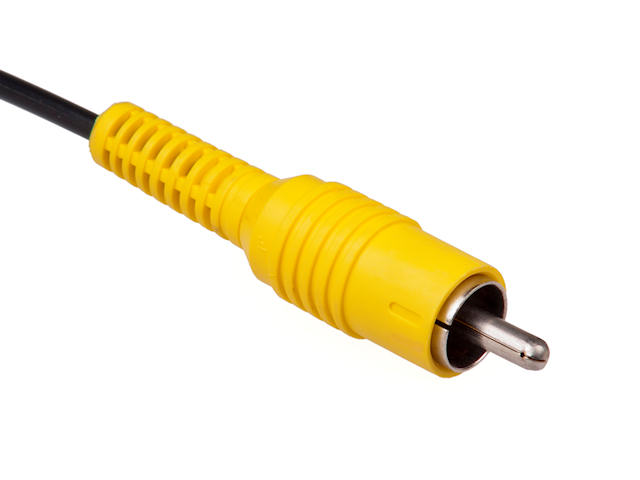
The yellow connector. Composite Video in and out. We all know and love this little fella. It is not the "yellow" signal as I have seen in discussion talking about commonent video. This is composite video. The signal that contains it all. Sync, video, chroma, closed captioning. Composite Video is of a specific voltage, and requires a specific working impedance for its distribution between video instruments. The spec is for a signal that is one volt peak to peak, terminated into 75 ohms. Well, golly Labguy! Exactly how do we deal with that strange requirement? What does it all mean? It means that we don't have to delve into deep theory to apply the technology to our needs. 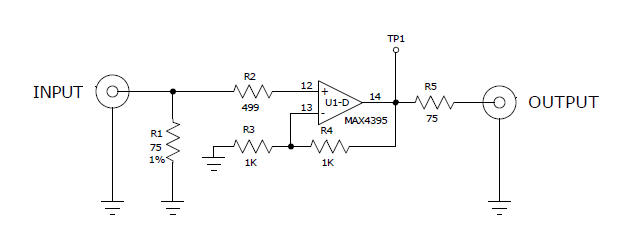
The classic video buffer amplifier This is the perfect place to start. Let's properly receive a composite video signal, amplify it, and send it back out with 75 ohms impedance. Imagine two of these amplifers, one driving the other. Note that this puts the output resistor R5 in series with R1, the input terminating resistor. This means that from the output of the amplifier, to the input of the next amplifier takes the form of a two to one voltage divider, R5 & R1. To see one volt at the top of R1, the amplifier U1D, must put out two volts at test point TP-1. Note that the op amp circuit is configured for a voltage gain of two. For a high impedance input, remove R1. 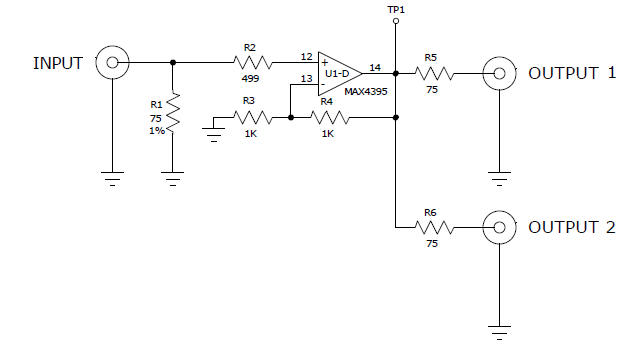
Two to one distribution amplifier Referring to U1D, R2, R3, and R4. If you recall your op amp theory, you will see the amplifier is configured for a voltage gain of two. (R3 = R4) The purpos of R2 is to balance the currents in the plus and minus inputs to reduce introducing DC shifts in the video. R2's value is equal to the value of R3 in parallel with R4. (R2 = R3 // R4). The bandwidth of this circuit extends to almost 10 Mhz. The open loop bandwidth of the MAX4395 is 85Mhz. The MAX4395 can also drive up to two 150 ohm loads, so it makes a handy one input, two output, distribution amplifier! You get up to four of these in one tiny chip! 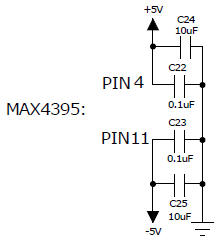
Power supply filtering for the MAX4395 The first order of the day is good clean plus and minus five volts DC to run the op amps. Next is to provide adequate noise bypassing at the power pins of the MAX4395. I look at the function of thes caps in two simplistic ways. One is that they are a reservoir of charge for when the chip makes a sudden demand for power. OR the DC does not see the capacitors and flows into the chip while the capacitors look like a direct short to ground for any AC signal riding on the power line. The 10uF capacitor is for all signals from a few Hz to a few hundred Hz. The 0.1uF soaks up all of the noise above the frequency response of the larger capacitor. Though, these modern high value caps do have very impressive bandwidth unlike the electrolytic types. I use a 10uF, 25V surface mount ceramic capacitor that fits on the one tenth inch grid of solder pads on the vector board. It is leadless and totally devoid of any practical inductance. To learn more about physical circuit construction, visit the [Hobby Electronics How To] page where I discuss practical assembly. Returning to our circuit, the Op Amp is the [MAX4395ESD, available at Digi-Key] and is made by Maxim Integrated. The data sheet is also available at that link. Please download that. We will be using this chip a lot. It is not the only part available for this job. An internet search for "video op amp" should turn up many more. Also note that the MAX439x family is available as a single op amp (SC-70 package) and as a dual op amp (SO8 package). This quad unit is in the SO14 package. The pin spacing (pitch) is 50 mils (.65mm), or 20 to the inch, for "SO" (Small Outline) size ICs. To learn more about physical circuit construction, visit Labguy's [Hobby Electronics How To] page. The vector board I use has a grid of holes with a pitch of 100 mils or 1/10 of an inch. The adpaters make applying these surface mount parts a breeze. The red adapter boards, that I use frequently, are made by [ElectroBoards]. It is [model number SO14-50-EB]. 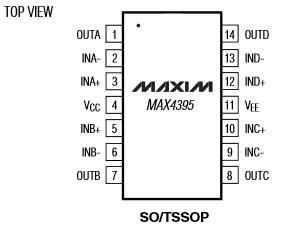


MAX4395ESD+ a quad video op amp and the chip mounted to various adapters. Mounted to an adapter board, this part makes four complete video amplifiers that take up just a little under one square inch of board space. Middle photo, near pins 4 and 11, you will see where I installed two 0.1uF surface mount capacitors. They are the small brown blocks obscuring the numbers 4 and 11. These capacitors are important and should always be installed as close to the chip as possible. Benath the vector board, are two 10uF capacitors that are in parallel with the two on top. This forms a very effective DC power line noise filter. The third photo is an home made adapter, about half the size of the commercial board. The size reduction offsets the greater effort to build it, if space is tight. It could also be dead bug wired to the underside of the vector board and skip the small piece of board and jumper pins altogether. COMING SOON: Video waveforms! No really. The page is still under construction. [HOME] [VIDEO CIRCUITS COOK BOOK] Created: May 25, 2014 Last updated: May 27, 2014 |